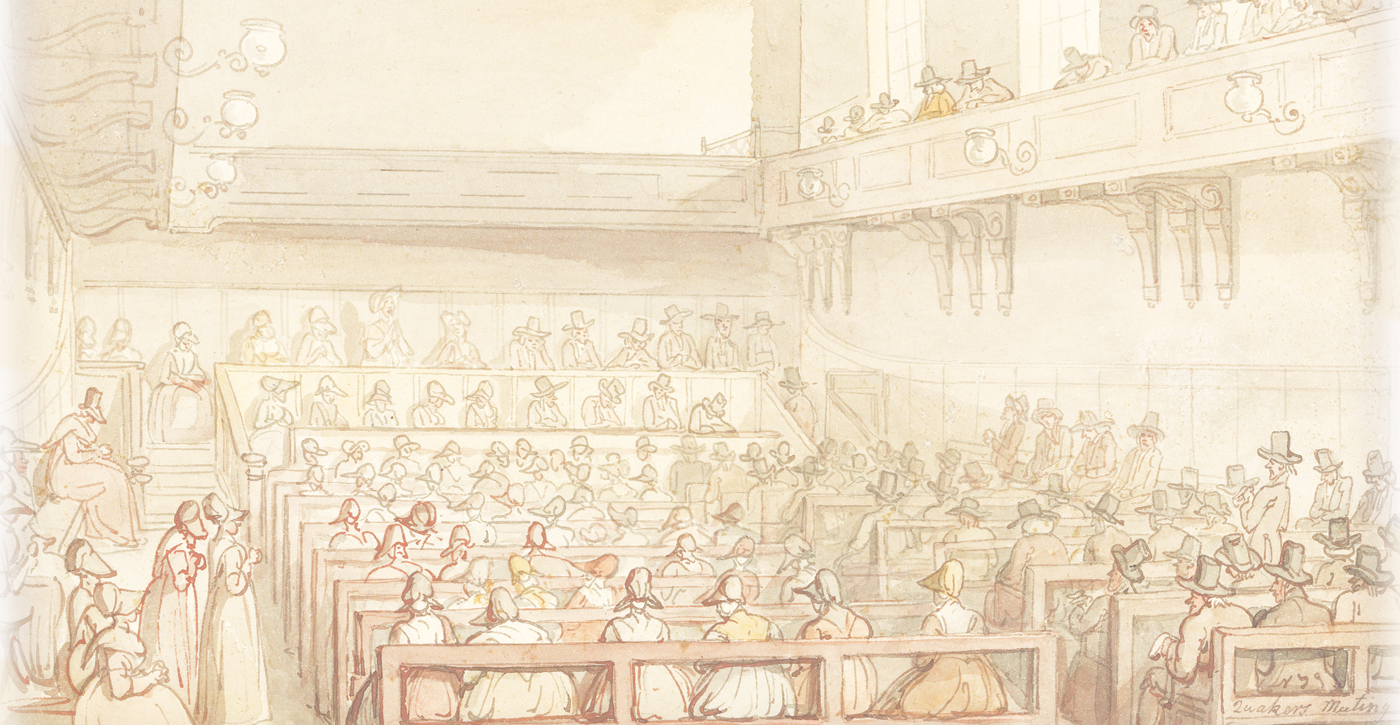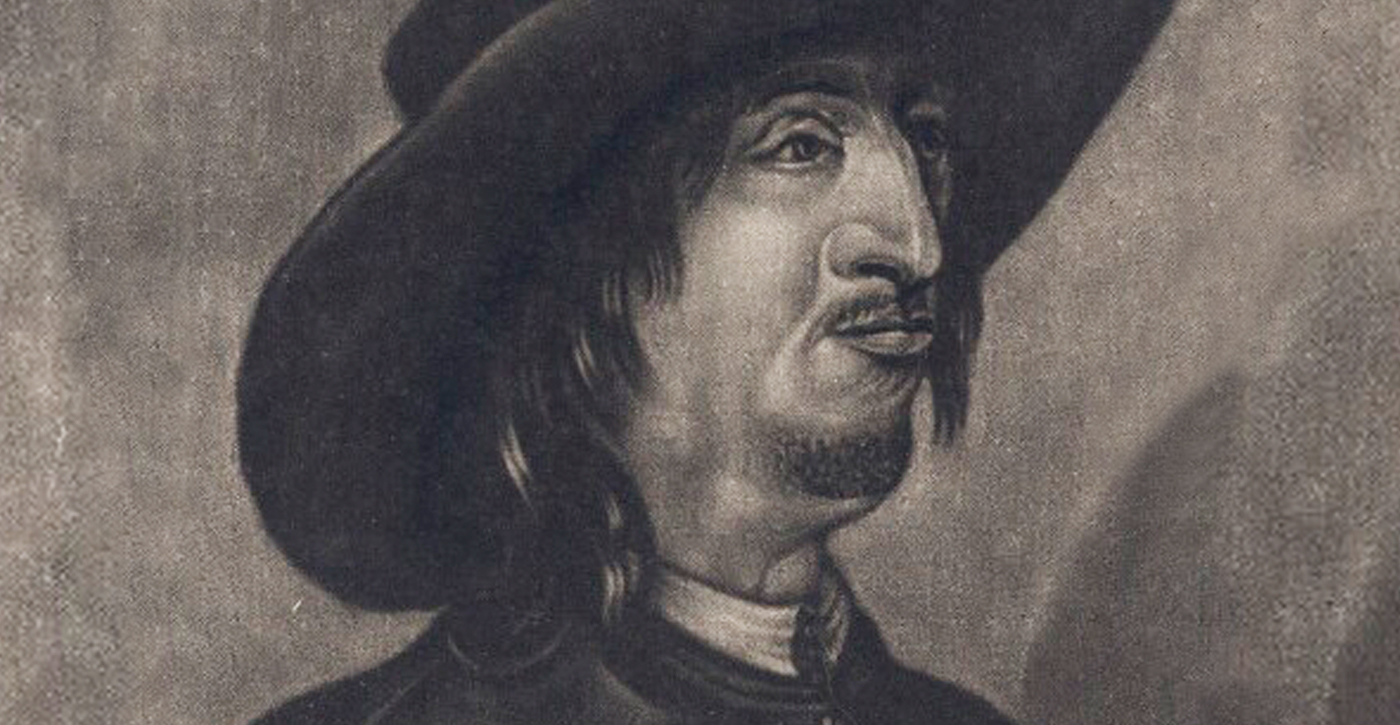No More Scapegoats
Contemporary Friends, at least of the Liberal variety, do not often think or speak of atonement. For many, the word has the worn-out feel of a previous era’s dogmas and doctrines, the very essence of what George Fox derided as “notions.” But the language of atonement was not unknown among early Friends—usually with a characteristic inward emphasis. In The Great Mystery of the Great Whore Unfolded, George Fox wrote that “None know the atonement of Christ but by the light within.” William Penn testified in The Spirit of Truth Vindicated that “I never experienced real Atonement . . . but by the Reproofs of that Light wherewith Christ has enlightened me.”
Etymologically, atonement is “at-one-ment”: the state of being at one, in unity. A foundational Quaker experience is that the Inward Light of Christ, when attended to, can bring us into unity with the Divine, and with one another. Fox counseled in Epistle 46: “Mind the oneness, and that which keeps you in the oneness and unity . . . this one light leads you out of darkness into the everlasting day.” So in this non-doctrinal sense, atonement expresses an essential belief and experience of Quakers.
“Atonement” belongs to a nexus of words that refer to the change that God can bring to our lives; perhaps “transformation” would be a modern equivalent. In Christian experience and teaching, this change is intimately connected with the life, death, and resurrection of Jesus, but it is important to recognize that the New Testament does not present a single theory of atonement. Instead, it offers a rainbow of metaphors: salvation (originally, to heal or make whole); liberation (alluding to the Exodus story of escape from slavery in Egypt); new birth (or “born from above”); redemption (to purchase the freedom of a slave); adoption (of a favored slave into one’s family); justification (to be found innocent at trial); military victory (over sin and death); and reconciliation (negotiated peace between enemies).
In my view, the satisfaction theory of the atonement and its variants have done more than any other church teaching to discredit Christianity in the eyes of thoughtful seekers. No wonder Quakers—and many others—have largely stopped talking about atonement.
Given this rich history, what might account for our contemporary reticence to speak of atonement? I can think of two important reasons.
First, atonement is about restoring a broken relationship with God; atonement implies an understanding of human sinfulness that contemporary Quakers do not necessarily endorse. We sometimes hear it said that “Quakers do not believe in sin,” but that view cannot be supported by even a superficial reading of early Friends’ writings. While it is true that Quakers rejected Augustine’s doctrine of original sin, early Friends certainly talked about their experience of sin, as when Fox speaks of humans as “alienated from the life of God” in A Visitation to the Jews. If we think of sin as anything that separates us from God, then early Friends certainly knew the experience of sin, as well as its overcoming (which is what distinguished them from the Puritans)—in a word, atonement.
The second reason requires a foray into the historical details of Christian doctrine. Throughout history, the church has had many metaphorical ways of speaking about the saving, redeeming, and transforming work of God, and how it relates to the life and death of Jesus. But one specific view of atonement has cast a very long shadow: the satisfaction theory, first articulated by Anselm of Canterbury (1033–1109). Regardless of whether they have ever heard of Anselm, most Christians have come to implicitly accept some variation of Anselm’s theory—to the great detriment of Christian spirituality.
Writing at the time of the First Crusade and working from a medieval framework of honor and shame, Anslem argued that God was something like a feudal lord whose honor has been offended by the disobedience of his vassals. The Lord’s honor can be restored only by the offender paying a price, either by monetary payment or by appropriate punishment. Likewise, when God’s honor is offended by human sin, God’s perfect justice requires that a price must be paid in order to restore the moral order. But it is impossible for humans to pay that price, since we already owe the Creator everything, including our very lives—we have nothing to give that would satisfy. Only God is able to provide satisfaction, restoring the moral order by offering the Divine Son who is without sin to suffer and die in our place. Jesus’s death by crucifixion “pays the price” for human sin, which God’s honor demands. For Anselm, atonement requires punishment.
The early Protestant reformers further developed Anselm’s thought, with the penal substitution theory: “penal” because it involves a deserved legal punishment for breaking God’s law; and “substitution” because Jesus substitutes for us by accepting the suffering and death we deserve as the penalty for sin. This is simply a variation of Anselm’s satisfaction theory, now with Jesus’s death satisfying God’s demand for justice, rather than God’s offended honor.
Whatever value it might have had in its original medieval context, the shortcomings of the satisfaction theory leap out to a contemporary seeker. It portrays God as sadistic, so concerned with God’s own honor (or justice) that God needs to be placated by the death of the innocent Son, the theological equivalent of child abuse. It makes Christ into a passive victim of divine justice: crucified to satisfy the terms of some inscrutable transaction. It puts sole emphasis on Jesus’s death, entirely omitting both his ministry and his resurrection, as though his life’s entire purpose was simply to die. By turning salvation into a legalistic transaction, it divorces salvation from the radical ethics of the Kingdom. It ignores the role of the “powers that be” who, after all, were responsible for Jesus’s crucifixion, turning them instead into God’s agents. It sacralizes violence; God uses violence for a good purpose, so why shouldn’t we? It encourages a morbid spirituality that glorifies suffering. Finally, it seems to encourage passivity in the face of injustice. How many abused women and oppressed minorities have been counseled to “imitate Christ” by submitting to unjust suffering?
In my view, the satisfaction theory of the atonement and its variants have done more than any other church teaching to discredit Christianity in the eyes of thoughtful seekers. No wonder Quakers—and many others—have largely stopped talking about atonement.

Illustration by Cristina Conti
Toward a New Model
Despite the dominance of Anselm’s view, there have always been other ways to think about atonement. For hundreds of years before Anselm, the dominant image was of Christus victus, with Christ after the crucifixion descending into hell and defeating or tricking Satan, thereby freeing the captives. In the generation after Anselm, Peter Abelard (1079–1142) articulated the moral influence theory: Jesus’s death saves us not by placating God but by subjectively changing us, inspiring us by his example of sacrificial love and obedience.
The past several decades have seen the emergence of a number of new ways of understanding atonement, many of which reflect the perspectives of historically oppressed or disadvantaged groups. Most of these start by rejecting Anselm’s satisfaction theory, which is rightly criticized as serving the interests of a hierarchical and oppressive status quo. These new models seek to reconnect our understanding of atonement with the radical ethic of love, service, and nonviolence demonstrated in Jesus’s ministry, a connection completely lost by Anselm.
One of these new views seems particularly relevant to Friends’ work for peace and justice. It is rooted not in theological abstractions but in the anthropological insights of René Girard and his followers. According to Girard, the most basic aspect of our humanity is our capacity for mimesis (from the Greek, to imitate). Toddlers learn language by imitating their parents; older children learn survival skills by imitating adults. In human evolution, our hominid ancestors traded instinct for larger brains—and a vastly increased capacity for mimesis.
One of the qualities humans learn to imitate is desire; we come to desire what we see others desiring, or, in Girard’s phrase, “we desire according to the desire of the other.” If you doubt this, ask any parent what happens when two toddlers are together in a room full of toys. Inevitably, they come into conflict, as both desire the one toy that the other desires. Because mimetic desire can quickly lead to mimetic rivalry, primitive human groups larger than the extended family were at risk of falling into a state of anarchy or violence, of “all against all,” which could profoundly threaten group cooperation and survival. Girard’s key insight is that our ancestors were able to overcome this by spontaneously stumbling onto what he calls “the scapegoat mechanism.” When the source of the chaos is projected onto a single individual, “all-against-all” chaos can suddenly be transformed into “all-against-one” scapegoating. The group turns on one of its own, either killing or expelling a victim. Group cohesion is achieved but at the cost of an innocent victim.
These insights have implications for the origins of religion. The scapegoated victim is remembered as the source of disorder, and therefore a threat, but also in death as the source of social cohesion and protection, and therefore revered. Projected into the heavens, these innocent scapegoats became archaic gods, who were simultaneously a source of danger and protection. Ritual sacrifice—nearly universal in archaic cultures—is understood as an attempt to recreate and harness this scapegoat mechanism, promoting the group cohesion that makes culture possible. Archaic religion uses “good” violence (the scapegoating or sacrifice of a single individual) to overcome “bad” violence (the chaos of mimetic contagion), placating the gods and avoiding their wrath by sacrificing arbitrary victims (initially human, though eventually animal).
Traces of archaic religion, including divine violence and human sacrifice, can be found in the Hebrew Scriptures. But gradually, a subtext develops: the Hebrew people demonstrate a particular sensitivity to the plight of the victim. By fits and starts, they began to turn their attention away from the guilt of the scapegoat and toward the innocence of the victim. God is seen less and less as a projection of human violence, and more and more as redeemer and liberator.
The past several decades have seen the emergence of a number of new ways of understanding atonement, many of which reflect the perspectives of historically oppressed or disadvantaged groups. These new models seek to reconnect our understanding of atonement with the radical ethic of love, service, and nonviolence demonstrated in Jesus’s ministry.
This long process culminates in the life, ministry, and crucifixion of Jesus. Jesus twice quotes Hosea: “I desire mercy, not sacrifice” (Mt. 9:13, 12:7). He speaks of God as Abba, emphasizing compassion, forgiveness, and nonviolence. At the end of his life, Jesus was betrayed by Judas (Mk. 14:10), then abandoned by the rest of the disciples (Mk. 14:50). Peter, perhaps his closest disciple, denied him not once but three times (Mk. 14:66–72). Before the Jewish authorities, he was accused of the highest religious crime—blasphemy (Mt. 26: 65–66). Before Pilate, he was accused of the highest political crime—sedition (Lk. 23:2–3). The crowd, which just days before had greeted him with adulation, now chose the violent insurrectionist Barabbas over Jesus (Mk. 15:6–15). He was mocked, flogged, and tortured by the Roman soldiers (Mk. 15:16–20), and ultimately executed in a manner reserved for enemies of the empire.
Girard comments: “Jesus is not killed by the Romans alone, or by the Jewish priests alone, or by the crowd alone, but by everybody. It is a collective murder if ever there was one. Jesus is obviously a scapegoat.” In effect, Jesus was lynched—a point made by both Girard in Reading the Bible with René Girard and by African American theologian James H. Cone in his The Cross and the Lynching Tree.
The passion has the structure of countless myths before and since but with one crucial difference: the gospels clearly and repeatedly proclaim Jesus’s innocence. The good thief (Lk. 23:41), the centurion (Lk. 23:47), a repentant Judas (Mt. 27:3–4), and even Pilate (Lk. 23:4) all testify to Jesus’s innocence. For the scapegoating dynamic to work, it must be unanimous. But as the passion narrative unfolds, there are immediate cracks in that unanimity, and with the resurrection, the nascent Christian community becomes a dissenting minority within the larger culture.
Caiaphas speaks for “the powers that be” throughout history: “It is better for you to have one man die for the people than to have the whole nation destroyed” (Jn. 11:50). Jesus, like thousands before and since, was executed by the state, in the name of public order. But in the crucifixion, the scapegoat mechanism is decisively unmasked and revealed for what it is: unjustified human violence against an innocent victim. At least in this sense, Jesus can be said to have “died for our sins.” In Saved from Sacrifice, S. Mark Heim summarizes this view:
As surely as Jesus came between Barabbas and the cross, Jesus’ death on the cross comes between us and one specific evil to which we are collectively in thrall, scapegoating sacrifice. . . . The death of Jesus set in motion a very concrete historical effect, the unveiling and undermining of sacrifice. Christ died for us, to save us from what killed him. And what killed him was not God’s justice but our redemptive violence. . . . Christ died for us to stop us from having people die for us. Scapegoats die for us because we make peace that way. Christ became one of those scapegoats and died so that we could live without them. . . . Jesus became a scapegoat for us, but Jesus is not our scapegoat.
This perspective represents a potential sea change in our understanding of atonement. Gone is Anselm’s medieval idea of atonement as a legalistic transaction to appease God’s thirst for retribution, miraculously removing the consequences of human sin but without changing us (“imputed righteousness”). Instead, we begin to see atonement as an ongoing process of revealing and unmasking the universal human propensity to scapegoat innocent victims, attempting to achieve social cohesion by demonizing some “Other.” At-one-ment is not our individual ticket to heaven but the progressive enlargement of the human circle of care, from family to tribe to ethnic group to nation to world, and finally to all life—all the while resisting the temptation to create more victims.
As we seek new light on atonement, we would do well to consider these prescient words of Quaker theologian Rufus Jones, written over a hundred years ago in The Double Search (1906):
Whatever it has meant in the past . . . in the future the atonement must be vital and dynamic. It must be put in language which grips the heart, convinces the mind, and carries the will. . . . It will cease to signify a way by which God was appeased and it will come to express, as it did in the apostolic days, the identification of God with us in the person of Christ, and the identification . . . of ourselves with [God].







This is such a thought-provoking piece, I had to share it. Some of my friends might find it unpleasant, but I feel that it actually cuts to the heart of the situation with the crucification. Jesus didn’t die at the hands of one faction alone – it was a mob scene and he was the victim. We need to make certain that we don’t allow the same mistakes to be make over and over again as they have occurred in the past.
But we are making that same mistake over and over again. And Jesus is with each crucified, scapegoated victim in their dying1